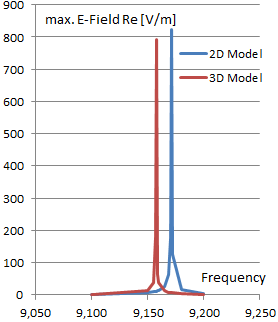 Der Full Wave Solver berücksichtigt alle Terme der Maxwellschen Gleichungen. Dadurch kann die Wellenlänge kleiner sein als die Abmessungen des untersuchten Teils und es sind sogar sehr hohe Frequenzen möglich. Im Frequenzbereich ergeben sich die elektrischen und magnetischen Felder aufgrund der Anregungsfrequenzen.
Der Full Wave Solver berücksichtigt alle Terme der Maxwellschen Gleichungen. Dadurch kann die Wellenlänge kleiner sein als die Abmessungen des untersuchten Teils und es sind sogar sehr hohe Frequenzen möglich. Im Frequenzbereich ergeben sich die elektrischen und magnetischen Felder aufgrund der Anregungsfrequenzen.
Features
- Plot: Magnetic Fluxdensity, Magnetic Fieldstrength, Electric Fieldstrength, Current Density, Eddy Current Losses Density, Vectorpotential, Nodal Force - virtual, Nodal Moment - virtual, Lorentz Force, Poynting Vector.
- Table: Total Force - virtual, Total Moment - virtual, Total Lorentz Force, Voltage on Circuits, Current on Circuits, Power on Circuits, Eddy Current Losses, Ohm Resistance, Inductivity, Phase Shift.
- Coupled Thermal: Temperature
Examples
| Waveguide Combiner |
|
||
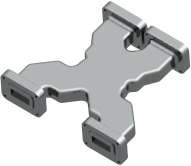 |
Theory and Basics
Formulations
The basis equations:
(1) rot h = j + δt d
(2) rot e = -δt b
(3) div b = 0
Constitutive relations:
(4) b = µ h
(5) d = ε e
(6) j = σ e
a-v-Formulation
The following a-v-formulation is used for 3D
Magnetic vectorpotential a,
electric scalar potential v:
(7) b = rot a
(8) e = -δt a – grad v
Magnetodynamic weak a-v-formulation with full wave extension:
(9) (µ-1 rot a, rot a’ )Ω
+ (σ δt a, a’ ) Ωc
+ (σ grad v, a’ ) Ωc
+ (σ δt a, grad v’ ) Ωc
+ (σ grad v, v’ ) Ωc
+ (ε δ2t a, a’ ) Ω
+ (ε δt grad v, a’ ) Ω
+ (ε δ2t a, grad v’ ) Ω
+ (ε δt grad v, grad v’ ) Ω
= 0
+Silver-Müller radiaton condition at infinity (outgoing waves)
Electric-field formulation
In case of wave guide solutions the solver uses the e-field formulation
(10) rot rot e + σ µ δt e + ε µ δ2t e = 0
The equation can be solved in the time or frequency domain.
Basic Example: Waveguide Loaded Cavity
The statement of this Team Workshop Problem 18 is to find the resonant frequency and other results of a square-shaped TE101 cavity coupled to a rectangular waveguide through a centered symmetrical inductive iris. All walls are perfectly conducting.
a = 22,86 mm
d = 2*a/8
L = 26,86 mm
t = a/32
The analysis is done in 2D and 3D. The pictures demonstrate these two meshes.
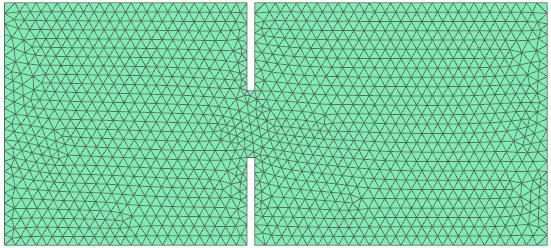
2D mesh with 2744 tri elements.
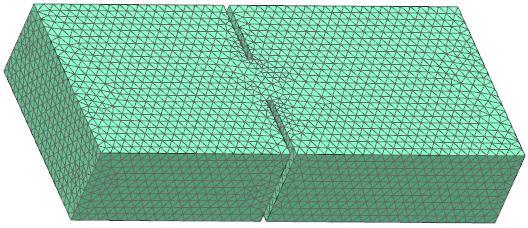
3D mesh with 38151 tetrahedral elements.
Results
Reference and Numerical Results
Reference results [1] are compared to the results of the Magnetics solution. They show a good agreement.
Reference Result:
Freq = 9,180 GHz
Numerical Result 2D mesh
Freq = 9,171 GHz
Deviation: 0,1%
Numerical Result 3D mesh
Freq = 9,158 GHz
Deviation: 0,24%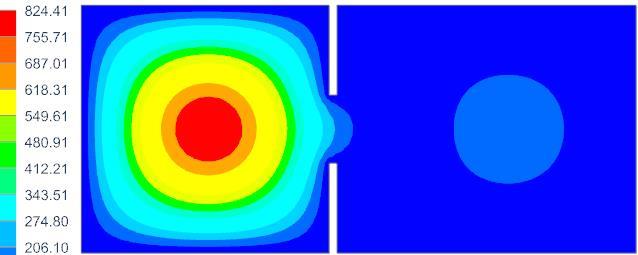
2D Result of E-Field Pattern [V/m]
Graph Maximum E-Field over Frequency
[1]: Bardi, I., Biro, O., Dyczij-Edlinger, R., Preis, K., & Richter, K. (1994b). Solution of TEAM Benchmark Problem 18 “waveguide loaded cavity”.

